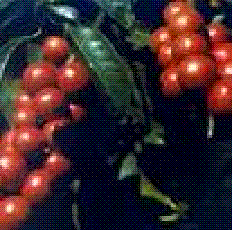
Garcinia indica is a fruit tree, of culinary, pharmaceutical, and industrial uses. The tree is also ornamental, with a dense canopy of green leaves and red-tinged tender emerging leaves. It is indigenous to the Western Ghats region of India, along the western coast. It is found in forest lands, riversides, and wasteland, and also gets cultivated on a small scale. It does not require irrigation, spraying or fertilizers.
These plants prefer evergreen forests, but some also thrive in relatively low-rainfall areas. Garcinia indica is known by various names across India -- including Bindin, Biran, Bhirand, Bhinda, Kokum, Katambi, Panarpuli, Ratamba or Amsol. In the English language, it is known by various names, such as mangosteen, wild mangosteen, or red mango. The genus Garcinia belonging to the family Clusiaceae includes some 200 species found in the Old World tropics, specially Asia and Africa. Out of the 35 species found in India, 17 are endemic. Of these, seven are endemic to the Western Ghats region (lying along western coastal India), six in the Andaman and Nicobar Islands and four in the North-Eastern region of India.
The genus Garcinia belonging to the family Clusiaceae includes some 200 species found in the Old World tropics, specially Asia and Africa. Out of the 35 species found in India, 17 are endemic. Of these, seven are endemic to the Western Ghats region (lying along western coastal India), six in the Andaman and Nicobar Islands and four in the North-Eastern region of India.
Called "kokum" or "bin'na" in parts of western India, the Garcinia indica seed contains 23-26% oil, which remains solid at room temperature and is used in the preparations of chocolates, medicines and cosmetics.
Recently, industries have started extracting Hydroxy Citric Acid (HCA) from the rind of the fruit. HCA is claimed to have fat-reducing properties for the human body. Scientists in India suggests that since this fruit reduced fat, cools the body, purifies the blood and fights cholesterol. Wines and liquores made from it could attract the health-conscious.
India's first national seminar on 'Kokum' or Garcinia indica was held March 4-5, 2005 at the Goa University, Goa. Those researching on the crop see it as having a bright future: it is rainfed, doesn't have any pest or diseases apart from the monkey menace, and is almost a "zero-attention" crop.
One paper presented at the Goa seminar (March 2005) suggests that the Garcinia indica has medicinal uses both as a digestive tonic, and to cope with paralysis. In the first case, about half to one glass of curry is prepared from the fruits, with a little salt and sugar, to be taken after meals. For paralysis, the clean-chopped stem bark is finely powdered and is added to boiling water. After 2-3 minutes, a lightly cooled decoction is used for washing the affected parts, two to three times a day.
| < Prev | Next > |
|---|
















